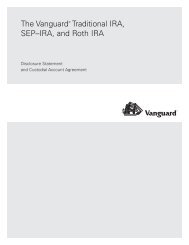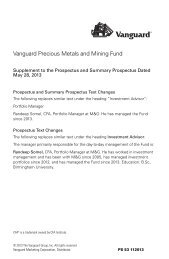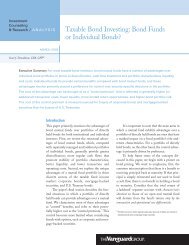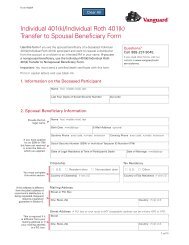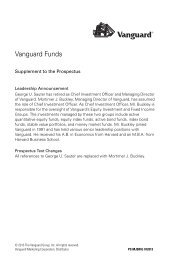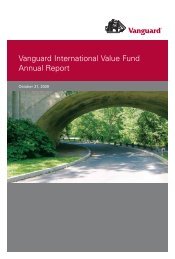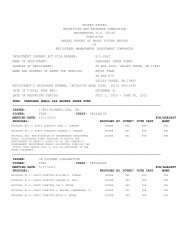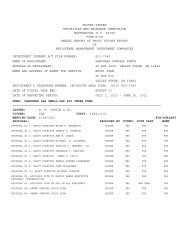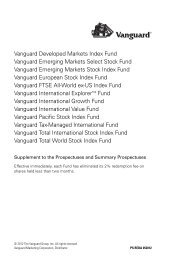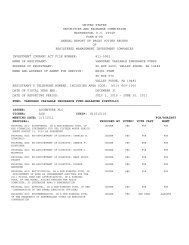Vanguard International Stock Index Funds Annual Report
Vanguard International Stock Index Funds Annual Report
Vanguard International Stock Index Funds Annual Report
Create successful ePaper yourself
Turn your PDF publications into a flip-book with our unique Google optimized e-Paper software.
European <strong>Stock</strong> <strong>Index</strong> Fund<br />
Notes to Financial Statements<br />
<strong>Vanguard</strong> European <strong>Stock</strong> <strong>Index</strong> Fund is registered under the Investment Company Act of 1940 as<br />
an open-end investment company, or mutual fund. The fund invests in securities of foreign issuers,<br />
which may subject it to investment risks not normally associated with investing in securities of U.S.<br />
corporations. The fund offers five classes of shares: Investor Shares, Admiral Shares, Signal Shares,<br />
Institutional Shares, and ETF Shares. Investor Shares are available to any investor who meets the<br />
fund’s minimum purchase requirements. Admiral Shares are designed for investors who meet certain<br />
administrative, service, tenure, and account-size criteria. Signal Shares are designed for institutional<br />
investors who meet certain administrative, service, and account-size criteria. Institutional Shares are<br />
designed for investors who meet certain administrative and service criteria and invest a minimum of<br />
$5 million. ETF Shares are listed for trading on the NYSE Arca, Inc.; they can be purchased and sold<br />
through a broker.<br />
A. The following significant accounting policies conform to generally accepted accounting principles for<br />
U.S. mutual funds. The fund consistently follows such policies in preparing its financial statements.<br />
1. Security Valuation: Securities are valued as of the close of trading on the New York <strong>Stock</strong> Exchange<br />
(generally 4 p.m., Eastern time) on the valuation date. Equity securities are valued at the latest quoted<br />
sales prices or official closing prices taken from the primary market in which each security trades; such<br />
securities not traded on the valuation date are valued at the mean of the latest quoted bid and asked<br />
prices. Securities for which market quotations are not readily available, or whose values have been<br />
affected by events occurring before the fund’s pricing time but after the close of the securities’<br />
primary markets, are valued at their fair values calculated according to procedures adopted by the<br />
board of trustees. These procedures include obtaining quotations from an independent pricing service,<br />
monitoring news to identify significant market- or security-specific events, and evaluating changes in<br />
the values of foreign market proxies (for example, ADRs, futures contracts, or exchange-traded funds),<br />
between the time the foreign markets close and the fund’s pricing time. When fair-value pricing is<br />
employed, the prices of securities used by a fund to calculate its net asset value may differ from<br />
quoted or published prices for the same securities. Investments in <strong>Vanguard</strong> Market Liquidity Fund<br />
are valued at that fund’s net asset value. Temporary cash investments acquired over 60 days to<br />
maturity are valued using the latest bid prices or using valuations based on a matrix system (which<br />
considers such factors as security prices, yields, maturities, and ratings), both as furnished by<br />
independent pricing services. Other temporary cash investments are valued at amortized cost,<br />
which approximates market value.<br />
2. Foreign Currency: Securities and other assets and liabilities denominated in foreign currencies<br />
are translated into U.S. dollars using exchange rates obtained from an independent third party as<br />
of the fund’s pricing time on the valuation date. Realized gains (losses) and unrealized appreciation<br />
(depreciation) on investment securities include the effects of changes in exchange rates since the<br />
securities were purchased, combined with the effects of changes in security prices. Fluctuations in<br />
the value of other assets and liabilities resulting from changes in exchange rates are recorded as<br />
unrealized foreign currency gains (losses) until the assets or liabilities are settled in cash, at which<br />
time they are recorded as realized foreign currency gains (losses).<br />
3. Futures and Forward Currency Contracts: The fund uses index futures contracts to a limited extent,<br />
with the objectives of maintaining full exposure to the stock market, enhancing returns, maintaining<br />
liquidity, and minimizing transaction costs. The fund may purchase futures contracts to immediately<br />
invest incoming cash in the market, or sell futures in response to cash outflows, thereby simulating a<br />
fully invested position in the underlying index while maintaining a cash balance for liquidity. The fund<br />
may seek to enhance returns by using futures contracts instead of the underlying securities when<br />
31




